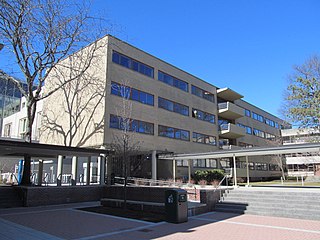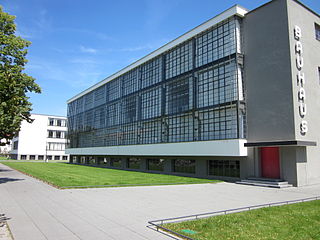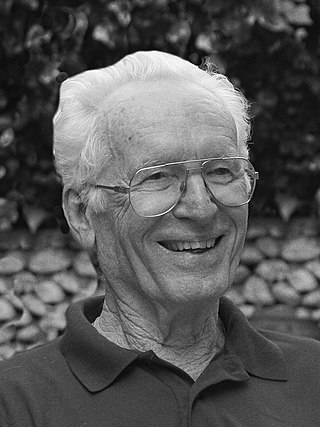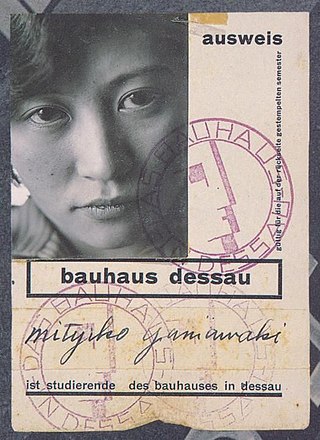
The Staatliches Bauhaus, commonly known as the Bauhaus, was a German art school operational from 1919 to 1933 that combined crafts and the fine arts. The school became famous for its approach to design, which attempted to unify individual artistic vision with the principles of mass production and emphasis on function. Along with the doctrine of functionalism, the Bauhaus initiated the conceptual understanding of architecture and design.

Walter Adolph Georg Gropius was a German-American architect and founder of the Bauhaus School, who, along with Alvar Aalto, Ludwig Mies van der Rohe, Le Corbusier and Frank Lloyd Wright, is widely regarded as one of the pioneering masters of modernist architecture. He was a founder of Bauhaus in Weimar (1919). Gropius was also a leading architect of the International Style.

Modern architecture, also called modernist architecture, was an architectural movement and style that was prominent in the 20th century, between the earlier Art Deco and later postmodern movements. Modern architecture was based upon new and innovative technologies of construction ; the principle functionalism ; an embrace of minimalism; and a rejection of ornament.

Josef Albers was a German-born American artist and educator who is considered one of the most influential 20th-century art teachers in the United States. Born in 1888 in Bottrop, Westphalia, Germany, into a Roman Catholic family with a background in craftsmanship, Albers received practical training in diverse skills like engraving glass, plumbing, and wiring during his childhood. He later worked as a schoolteacher from 1908 to 1913 and received his first public commission in 1918 and moved to Munich in 1919.

The MetLife Building is a skyscraper at Park Avenue and 45th Street, north of Grand Central Terminal, in the Midtown Manhattan neighborhood of New York City. Designed in the International style by Richard Roth, Walter Gropius, and Pietro Belluschi and completed in 1962, the MetLife Building is 808 feet (246 m) tall with 59 stories. It was advertised as the world's largest commercial office space by square footage at its opening, with 2.4 million square feet (220,000 m2) of usable office space. As of November 2022, the MetLife Building remains one of the 100 tallest buildings in the United States.

30 Rockefeller Plaza is a skyscraper that forms the centerpiece of Rockefeller Center in the Midtown Manhattan neighborhood of New York City, United States. Completed in 1933, the 66-story, 850 ft (260 m) building was designed in the Art Deco style by Raymond Hood, Rockefeller Center's lead architect. 30 Rockefeller Plaza was known for its main tenant, the Radio Corporation of America (RCA), from its opening in 1933 until 1988 and then for General Electric until 2015, when it was renamed for its current owner, Comcast. The building also houses the headquarters and New York studios of television network NBC; the headquarters is sometimes called 30 Rock, a nickname that inspired the NBC sitcom of the same name. The tallest structure in Rockefeller Center, the building is the 28th tallest in New York City and the 65th tallest in the United States, and was the third tallest building in the world when it opened.

Marcel Lajos Breuer was a Hungarian-German modernist architect and furniture designer. He moved to the United States in 1937 and became a naturalized American citizen in 1944.

Axa Equitable Center is an office skyscraper at 787 Seventh Avenue, between 51st and 52nd Streets, in the Midtown Manhattan neighborhood of New York City. Completed in 1986 and designed by Edward Larrabee Barnes, the building measures 752 feet (229 m) tall with 54 stories. Equitable Center West was developed by the Equitable Life Assurance Society adjacent to Equitable's existing skyscraper at 1285 Avenue of the Americas.
Events from the year 1963 in art.

Anni Albers was a German-Jewish visual artist and printmaker. A leading textile artist of the 20th century, she is credited with blurring the lines between traditional craft and art. Born in Berlin in 1899, Fleischmann initially studied under impressionist painter Martin Brandenburg from 1916 to 1919 and briefly attended the Kunstgewerbeschule in Hamburg in 1919. She later enrolled at the Bauhaus, an avant-garde art and architecture school founded by Walter Gropius in Weimar in 1922, where she began exploring weaving after facing restrictions in other disciplines due to gender biases at the institution.

1271 Avenue of the Americas (formerly known as the Time & Life Building) is a 48-story skyscraper on Sixth Avenue, between 50th and 51st Streets, in the Midtown Manhattan neighborhood of New York City. Designed by architect Wallace Harrison of Harrison, Abramovitz, and Harris, the building was developed between 1956 and 1960 as part of Rockefeller Center.

The Harvard Graduate Center, also known as "the Gropius Complex", is a group of buildings on Harvard University's Cambridge, MA campus designed by The Architects Collaborative in 1948 and completed in 1950. As the first modern building on the campus, it represents one of the first endorsements of the modern style by a major university and was seen in the national and architectural presses as a turning point in the acceptance of the aesthetic in the United States.
Anna Campbell Bliss was an American visual artist and architect. Her trademark artwork blends color, lights, mathematics, movement, science and technology. A modernist artist, Bliss, who was a pioneer of early computer generated art during the 1960s, was one of the first artists to utilize computer technology in her artwork. Examples of her work are included in the collections of the Art Institute of Chicago, the Cliff Lodge in Alta, the J. Willard Marriott Library, the Metropolitan Museum of Art, the Utah Museum of Contemporary Art, and the Utah Museum of Fine Arts. She also designed houses with her husband, architect and professor Robert Bliss, through their architectural practice, Bliss & Campbell Architects.
Beate "Ati" Gropius Johansen was a German-born graphic designer, artist, teacher, and illustrator. Her adoptive parents were Modernist architect Walter Gropius and his second wife Ise Frank Gropius, who was Ati's biological aunt. Throughout her career she illustrated 47 books. Her work is now part of various art institutions' collections.

The Bauhaus was seen as a progressive academic institution, as it declared equality between the sexes and accepted both male and female students into its programs. During a time when women were denied admittance to formal art academies, the Bauhaus provided them with an unprecedented level of opportunity for both education and artistic development, though generally only in weaving and other fields considered at the time to be appropriate for women.

Butterfield House is a cooperative apartment building on West 12th Street in the West Village neighborhood of Manhattan, New York City. It was designed by the architects and urban planners William J. Conklin and James Rossant then of Mayer, Whittlesey & Glass. It is situated between Fifth Avenue and Sixth Avenue within the Greenwich Village Historic District. The building was described in The New York Times as "a modernist landmark" that "received numerous accolades when it was built in 1962".

Bauhaus and its Sites in Weimar, Dessau and Bernau is a World Heritage Site in Germany, comprising six separate sites which are associated with the Bauhaus art school. It was designated in 1996 with four initial sites, and in 2017 two further sites were added.

Alexander Cvijanović was a Yugoslav-American architect. He was a close associate of Walter Gropius and partner of The Architects Collaborative.

Michiko Yamawaki, was a Japanese designer and textile artist who trained at the Bauhaus. She was one of four Japanese students to study at the Bauhaus in Dessau, studying drawing, weaving, and typography.

The United Nations General Assembly Building is part of the headquarters of the United Nations in the Turtle Bay neighborhood of Manhattan in New York City. It contains the main assembly hall of the United Nations General Assembly, the main deliberative, policymaking, and representative organ of the United Nations (UN). The building was designed by a group of architects led by Wallace Harrison. It is connected to the other buildings in the UN headquarters, including the Secretariat Building and the Dag Hammarskjöld Library. Although the building is physically within the United States, it is exempt from some local regulations because the site is under UN jurisdiction.

















